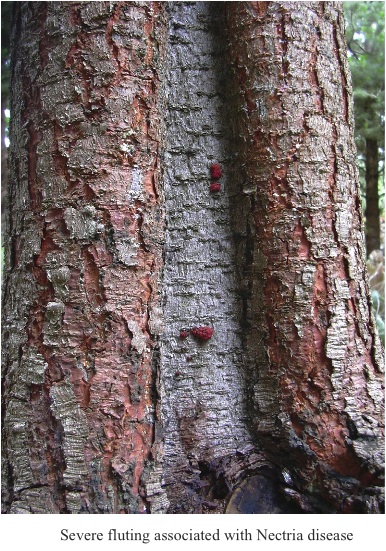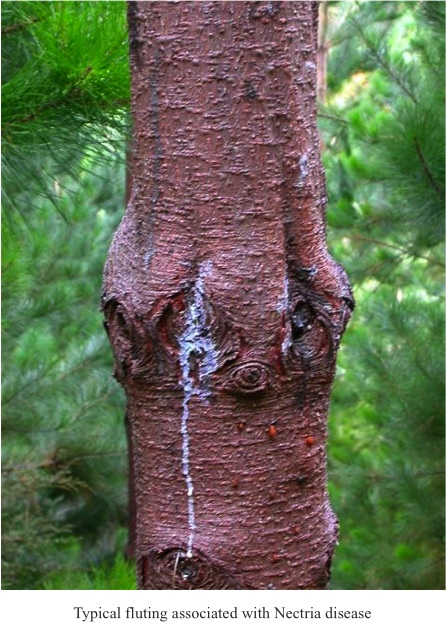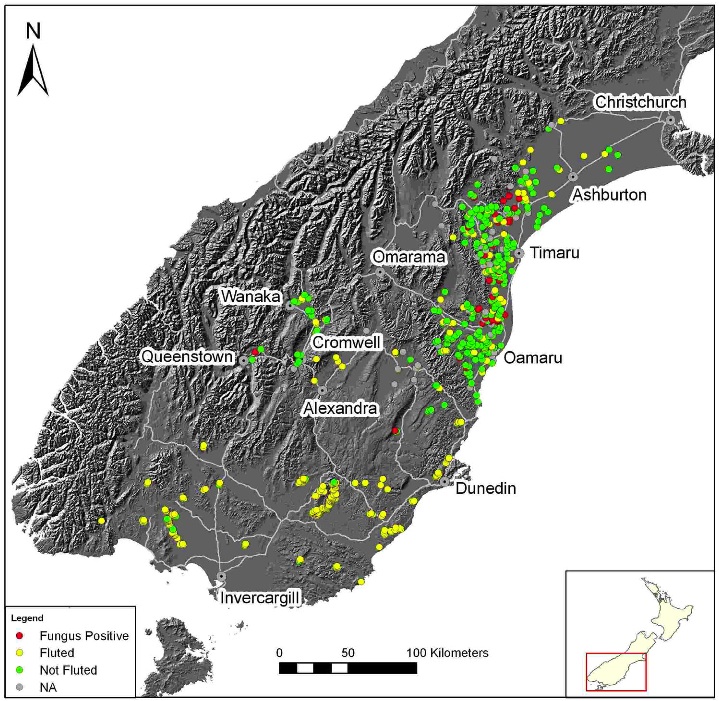PESTS AND DISEASES OF FORESTRY IN NEW ZEALAND
Nectria disease of Pinus radiata
Scion is the leading provider of forest-related knowledge in New Zealand
Formerly known as the Forest Research Institute, Scion has been a leader in research relating to forest health for over 50 years. The Rotorua-based Crown Research Institute continues to provide science that will protect all forests from damage caused by insect pests, pathogens and weeds. The information presented below arises from these research activities.
From Forest Health News 170, February 2007.
- Nectria disease of Pinus radiata
- Nectria pruning trial
- Nectria surveys
- Nectria infection of nursery stock
- Nectria field guide available
Nectria disease of Pinus radiata
 Stem malformation, typically developing after pruning, has become a problem in some Pinus radiata plantations in part of the South Island of New Zealand over the last 10 years. The condition is associated with infection by the fungus Nectria fuckeliana and is known as “Nectria flute canker”. Infection through the pruned branch stub may result in extensive stain and decay within the stem, although tree crowns generally remain green and healthy. Nectria fuckeliana is a Northern Hemisphere fungus which is commonly recorded there as a saprophyte or weak pathogen of species of Picea and Abies . The fungus had not been recorded in New Zealand prior to 1996, although it may have been present for some years prior to that date.
Stem malformation, typically developing after pruning, has become a problem in some Pinus radiata plantations in part of the South Island of New Zealand over the last 10 years. The condition is associated with infection by the fungus Nectria fuckeliana and is known as “Nectria flute canker”. Infection through the pruned branch stub may result in extensive stain and decay within the stem, although tree crowns generally remain green and healthy. Nectria fuckeliana is a Northern Hemisphere fungus which is commonly recorded there as a saprophyte or weak pathogen of species of Picea and Abies . The fungus had not been recorded in New Zealand prior to 1996, although it may have been present for some years prior to that date.
Forest industry and research providers have formed a “Nectria Focus Group” to co-ordinate research projects directed at understanding the epidemiology of the disease, and at finding effective management strategies. Updates on projects were presented at the March 2007 meeting of the focus group and summaries of some of this work are provided in this issue of Forest Health News.
(Margaret Dick)
Nectria pruning trial
 A trial to determine the effect of pruning and stub treatment on Nectria disease development was established in February 2003. The aims of the trial were to develop a management strategy to reduce the incidence of defect associated with pruned stubs by:
A trial to determine the effect of pruning and stub treatment on Nectria disease development was established in February 2003. The aims of the trial were to develop a management strategy to reduce the incidence of defect associated with pruned stubs by:
- Examining the effect of season of pruning on disease development
- Examining the effect of stub treatment with a protective fungicide on disease development
- Determining how long freshly pruned stubs are susceptible to infection, in both summer and winter.
The trial delivered clear trends that have not changed for some time. Fluting incidence is related to stub size — stubs smaller than 30 mm were rarely associated with fluting. Winter pruning resulted in more infection than summer pruning. Inoculation immediately after pruning resulted in increased infection. Fruit bodies take at least 9 months to develop after treatment and flute development is slow. The incidence of trees with flutes after the first-lift pruning operation increased from 30% immediately after pruning to almost 70% after 12 months and then to 15% after 4 years. However, 12 months after the second-lift pruning was carried out the incidence of trees affected was back up to 70%.
The most significant results from the trial, from a management perspective, are that pruning operations should be avoided in winter, and that fungicidal treatment of small stubs will not reduce overall disease incidence and therefore should not be done.
(Lindsay Bulman)
Nectria surveys
The Forest Industry Development Agenda (FIDA) and the Forest Biosecurity Research Council funded two major Nectria surveys over the last 14 months. A delimiting survey to determine the distribution of Nectria fuckeliana was carried out in North Otago and South Canterbury during early 2006, followed by an extension northwards in November to just north of the Rakaia river. In addition, a detailed regional survey of forests in Southland and Otago was carried out from October 2006 to March 2007. The aims of the regional survey were to determine the incidence and severity of disease in an area known to be infected for over 5years, and to determine any relationships between disease and other features such as host age, silviculture, topography, altitude, and aspect.
For the delimiting survey, samples were sent in to the Ensis FBP diagnostic laboratory for confirmation of the presence of Nectria fuckeliana if fluting (depressions on the stem — often associated with Nectria fuckeliana infection) was seen. For the regionalsurvey, fluting was assessed on individual trees but samples were not taken. The fungus was found as far north as Geraldine. Fluting was present throughout North Otago and South Canterbury, but was not as common as in Otago and Southland where 24% of trees assessed had flutes. Fluting and positive records of the fungus were not common in Central Otago.
On 7 March 2007, Nectria fuckeliana was confirmed from a sample collected on Banks Peninsula during the national forest health surveillance programme. This is the northernmost find to date. The delimiting survey will be extended into North Canterbury in April.
(Lindsay Bulman)

Nectria infection of nursery stock
The first confirmed record of Nectria fuckeliana was from Otago in 1996 and it has since been found extensively in southern South Island locations. During the period 1997–2004 thousands of Pinus radiata seedlings and cuttings were bought from South Island nurseries for planting out in a range of locations in the North Island. Although there are no records of N. fuckeliana from the North Island there has been some concern that it may have been transported to the North Island via the nursery stock.
As N. fuckeliana is a wound pathogen, intact seedlings or cuttings are very unlikely to have the opportunity to become infected. However, as topping of nursery material is routinely undertaken there is theoretically the possibility that, if there is an inoculum source nearby, the wound could become infected. A site adjacent to a Nectria -infected stand in Berwick Forest was selected for a field trial. In August 2005 newly established seedlings and cuttings (220 of each) were topped and half of the plants were inoculated with a spore suspension of N. fuckeliana .
The remaining, uninoculated, plants were exposed to any natural inoculum that might spread from the adjacent P. radiata. Half of the plants from each treatment were collected for examination and isolations in the laboratory 3 months after trial establishment. The remainder were harvested after 12 months.
Isolation results are shown in the table below.
| Treatment Nectria recovery (%) | ||
|---|---|---|
| at 3 months | at 12 months | |
| Inoculated seedings | 24 | 3.5 |
| Uninoculated seedlings | 2 | 0 |
| Inoculated cuttings | 7 | 0 |
| Uninoculated cuttings | 0 | 0 |
None of the plants showed any signs of ill-health. Discoloration in the tissues was consistent with normal response to an injury and did not differ between inoculated and uninoculated plants.
All of the stems were colonised by several fungi, including those from which N. fuckeliana was recovered. Most were known saprophytes commonly associated with P. radiata . Nectria was obtained only from the tissue in the top of the plants. It had not grown beyond the top 300 mm.
Nectria was recovered from only one of the total of 220 uninoculated plants tested. It is possible that this positive finding was the result of cross-contamination from the inoculated plants rather than from natural inoculum from the surrounding stand. After 12 months only two of the inoculated plants still carried N. fuckeliana. In this trial plants were inoculated within 3 hours of injury, thereby ensuring maximum chance of establishment of an infection. In the natural environment small wounds rapidly form a defensive barrier against invasion of pathogens. Also, competing micro-organisms, many saprophytic, may occupy the niche and prevent colonisation by others. Coupling these results with the knowledge that the nurseries are not sited close to an inoculum source, and therefore not exposed to spores, leads to the conclusion that nursery stock is very unlikely to represent a pathway for transport of Nectria.
(Margaret Dick)
Nectria field guide available
A field guide for use in the identification of Nectria flute canker has been prepared with funding from the Nectria Focus Group, the Forest Health Research Collaborative, and the Forest Biosecurity Research Council. A need for such a visual guide was identified because of the range of symptoms seen — in particular, wide variation in stem fluting, and the potential to confuse Nectria flute canker symptoms with those of other diseases such as Diplodia whorl canker.
The objective of this field guide is to assist in the identification of Nectria disease symptoms with particular reference to trees being assessed for pruning or for disease incidence. The guide shows characteristics of internal stem damage and fungal fruiting bodies, and will allow the field diagnosis of disease occurrence and severity both within known infested stands and in stands outside the known infested area. Recognition of symptom severity by age class and silvicultural treatment will assist forest managers in disease incidence assessment and tree selection, as well as disease detection. The guide is available in electronic format that will allow users to construct their own strategy specific guides for tree selection or disease assessment purposes.
Member companies of the Nectria Focus Group and of the Forest Health Research Collaborative (FHRC) have each received a CD of the guide and it is also posted on the FHRC website http://www.fhrc.org.nz/
(Margaret Dick)
This information is intended for general interest only. It is not intended to be a substitute for specific specialist advice on any matter and should not be relied on for that purpose. Scion will not be liable for any direct, indirect, incidental, special, consequential or exemplary damages, loss of profits, or any other intangible losses that result from using the information provided on this site.
(Scion is the trading name of the New Zealand Forest Research Institute Limited.)

 Farm Forestry New Zealand
Farm Forestry New Zealand

